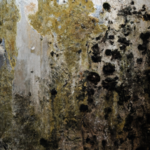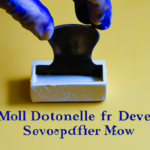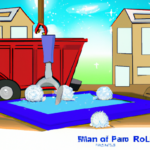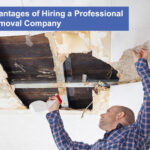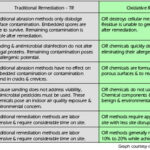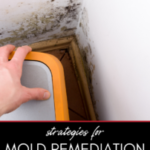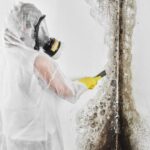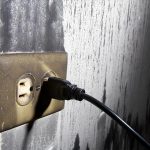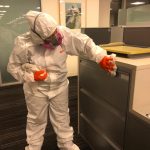In need of some expert advice on mold removal? Look no further than “The Ultimate Guide to Mold Removal.” This comprehensive guide will provide you with all the information you need to effectively tackle mold issues in your home or business. From identifying different types of mold to implementing effective removal techniques, this guide has got you covered. Don’t let mold damage your property and impact your well-being. With the help of SERVPRO of West Pensacola, you can ensure a clean and mold-free environment. Reach out to them today for professional assistance in Pensacola, Florida.
Table of Contents
Toggle- Understanding Mold
- The Health Risks of Mold
- Identifying Mold Infestation
- DIY Mold Removal vs. Professional Services
- Preparing for Mold Removal
- Mold Removal Techniques
- Disposing of Mold-Contaminated Materials
- Preventing Future Mold Growth
- Mold Prevention Products and Treatments
- Choosing the Right Mold Removal Company
Understanding Mold
Mold is a type of fungus that can grow almost anywhere, both indoors and outdoors. It thrives in damp and humid environments and reproduces by producing spores. These spores can be carried through the air, leading to the spread of mold. While some molds are harmless, others can cause serious health issues and damage to your property. Understanding the basics of mold can help you take appropriate actions to prevent and address mold growth in your home or office.
What is Mold?
Mold is a common term used to describe various species of fungi. It comes in different colors, including green, black, white, and orange. Mold reproduces by releasing tiny spores into the air, which can easily spread and land on surfaces. These spores are not visible to the naked eye and can survive in harsh environmental conditions, waiting for the right conditions to grow.
The Dangers of Mold
While not all molds are harmful, some can pose serious health risks and damage your property. Mold releases mycotoxins, which can cause allergic reactions and respiratory issues in individuals who are sensitive or exposed to high concentrations. Prolonged exposure to mold can also lead to skin irritation, headaches, fatigue, and even neurological problems. Additionally, mold can cause structural damage to buildings, leading to costly repairs.
Common Types of Mold
Several types of mold can be found indoors, with some being more common than others. Some of the most frequently encountered molds include Aspergillus, Cladosporium, Penicillium, and Stachybotrys (also known as black mold). Each type of mold possesses different characteristics, such as color and texture, and may require specific treatment methods.
Causes of Mold Growth
Mold requires certain conditions to grow and thrive. The most crucial factor is moisture. Areas with high humidity, water leaks, condensation, or flooding can create the perfect breeding ground for mold. Poor ventilation and insufficient airflow can also contribute to mold growth. It’s essential to be aware of these conditions and take prompt action when signs of mold growth are present.
The Health Risks of Mold
Mold exposure can have various adverse effects on human health. Some individuals may be more susceptible to mold-related health problems than others. Understanding the potential health risks of mold is crucial, especially if you or your loved ones have existing respiratory conditions, allergies, or weakened immune systems.
Respiratory Issues
Inhaling mold spores can trigger respiratory issues, particularly in individuals with asthma, allergies, or compromised immune systems. Common symptoms include coughing, wheezing, bronchitis, and exacerbated asthma symptoms. Prolonged exposure to mold can lead to more severe respiratory complications, such as fungal infections and allergic bronchopulmonary aspergillosis.
Allergic Reactions
For many people, mold exposure can cause allergic reactions. These reactions can manifest as sneezing, runny nose, itchy or watery eyes, and skin rashes. The severity of allergies can vary from mild discomfort to more severe symptoms, depending on the individual’s sensitivity and the type and concentration of mold present.
Skin Irritation
Direct contact with mold or handling contaminated materials can lead to skin irritation, such as redness, itching, and rash. Sensitized individuals may experience more severe reactions, including hives or dermatitis. It is crucial to wear protective gear when dealing with mold to minimize the risk of skin irritation.
Headaches and Fatigue
Mold exposure has been linked to headaches, fatigue, and difficulty concentrating. Mold toxins can affect the central nervous system, potentially leading to neurological symptoms. If you frequently experience unexplained headaches or persistent fatigue in your home or office, mold growth could be the culprit.
Identifying Mold Infestation
Spotting mold growth early is essential for effective remediation and minimizing the health risks associated with mold exposure. Knowing how to identify signs of mold can help you take prompt action.
Visible Signs of Mold
Mold often appears as colored patches or stains on various surfaces, such as walls, ceilings, floors, and furniture. Common signs of mold include black, green, or fuzzy growth. Pay attention to areas prone to moisture, such as bathrooms, kitchens, basements, and windowsills, as mold is more likely to grow in these areas.
Musty Odor
Another telltale sign of mold infestation is a musty or earthy odor. Mold releases volatile organic compounds (VOCs) as it grows, resulting in a distinct smell. If you notice an unpleasant odor that persists despite regular cleaning, it is crucial to investigate further for potential mold growth.
Moisture and Humidity Levels
Mold thrives in damp and humid conditions. If you have experienced water leaks, flooding, or high humidity levels, be vigilant for signs of mold growth. Monitor areas prone to moisture, such as basements, crawl spaces, and bathrooms, and ensure proper ventilation to minimize the risk of mold infestation.
Professional Mold Inspection
If you suspect mold but are unsure about its presence or extent, it is advisable to hire a professional mold inspection company. Mold inspectors have the expertise and specialized tools to accurately assess your property for mold growth. They can identify hidden mold, perform air quality testing, and provide a detailed report, helping you determine the best course of action for mold removal.
DIY Mold Removal vs. Professional Services
When faced with mold growth, many individuals wonder whether they should attempt to remove it themselves or hire professional mold removal services. While certain cases may be suitable for DIY approaches, others require the expertise and equipment of professionals. Consider the following factors when deciding between DIY and professional mold removal.
Benefits of Professional Mold Removal
Professional mold removal services offer several advantages over DIY approaches. Experienced mold remediation companies have the knowledge and skills to handle mold safely and effectively. They can assess the extent of the problem, identify the root causes of mold growth, and provide comprehensive solutions tailored to your specific situation. Additionally, professional mold remediators have access to specialized equipment and advanced techniques that may not be available to the average homeowner.
When to Consider DIY Mold Removal
In some cases, DIY mold removal may be appropriate, such as when dealing with small, isolated patches of mold on non-porous surfaces. DIY methods can involve using household cleaners, such as bleach or vinegar, to scrub off the visible mold. It is essential to wear protective gear, including gloves and a mask, to minimize exposure to mold spores. However, it is crucial to note that DIY methods may not be effective for extensive or hidden mold growth, and improper handling can lead to cross-contamination or incomplete removal.
Limitations of DIY Mold Removal
DIY mold removal has its limitations. It may not be sufficient for large or widespread mold infestations, especially if the mold has infiltrated porous surfaces or hidden areas. Improper handling and inadequate removal can lead to regrowth, exposing you to ongoing health risks. DIY methods also lack the advanced techniques and equipment used by professionals, potentially resulting in incomplete mold removal or inadequate addressing of the root causes of mold growth.
Choosing the Right Mold Remediation Company
Selecting the right mold remediation company is crucial for a successful and long-lasting resolution to your mold problem. When choosing a mold removal company, consider the following factors:
Experience and Expertise
Look for a company with extensive experience in mold remediation. Experienced professionals understand various mold species, their characteristics, and the most effective removal methods. They can also address any underlying issues contributing to mold growth, ensuring a comprehensive solution.
Certifications and Training
Check if the company holds certifications from reputable organizations, such as the Institute of Inspection, Cleaning and Restoration Certification (IICRC) or the National Organization of Remediators and Mold Inspectors (NORMI). These certifications indicate that the company’s technicians have undergone rigorous training and adhere to industry best practices.
References and Reviews
Read online reviews and testimonials from previous customers to gauge the company’s reputation. Ask for references and contact past clients to inquire about their experience with the mold removal company. Positive feedback and satisfied customers are indicators of a reliable and reputable service provider.
Insurance and Licensing
Ensure that the mold removal company is properly licensed and carries adequate liability insurance. Mold removal can be a complex process, and working with a licensed and insured company provides an added layer of protection and peace of mind.
Preparing for Mold Removal
Before mold remediation can begin, proper preparation is crucial to ensure safety and the effectiveness of the removal process. Follow these steps to prepare your space for mold removal:
Safety Precautions
Ensure the safety of yourself and others by taking necessary precautions before starting the mold removal process. This includes turning off electrical power in the affected area, restricting access to the space, and keeping pets and vulnerable individuals away from the contaminated area.
Protective Gear
When dealing with mold, it is essential to wear appropriate protective gear to minimize exposure to mold spores and chemicals. This includes wearing gloves, a mask or respirator, safety goggles, and disposable coveralls.
Isolating the Contaminated Area
Containment is necessary to prevent cross-contamination during mold removal. Close all doors and windows leading to the affected area and seal them with plastic sheeting. Cover vents and ducts to prevent the spread of mold spores throughout your property.
Removing Personal Belongings
Remove any personal belongings from the affected area to prevent further contamination and damage. Place these items in sealed plastic bags or containers to minimize the risk of spreading mold spores to other areas of your home or office.
Mold Removal Techniques
several techniques can be employed to remove mold effectively. The choice of method depends on various factors, such as the extent of mold growth, the type of affected surfaces, and the specific species of mold present.
Dry Mold Removal
Dry mold removal can be performed on non-porous surfaces with small patches of mold growth. This method involves brushing or scrubbing the affected area with a stiff brush or cloth to physically remove the mold. It is important to avoid creating airborne mold spores, so wetting the area beforehand or using a HEPA vacuum during the process is recommended.
Wet Mold Removal
Wet mold removal is suitable for porous surfaces, such as drywall, carpets, and fabrics. This method involves using water or a mold removal solution to clean and disinfect the affected area. The contaminated materials may need to be removed and replaced if they cannot be adequately cleaned.
HEPA Vacuuming
High-Efficiency Particulate Air (HEPA) vacuums can effectively remove airborne mold spores and settled spores from surfaces. HEPA filters trap small particles, preventing them from being released back into the air. Vacuuming is often used in conjunction with other mold removal techniques to ensure thorough cleaning.
Surface Disinfection
After physically removing mold, it is essential to disinfect the affected surfaces to kill any remaining mold spores. This can be done using commercial mold disinfectants or a mixture of water and detergent. Thoroughly clean and dry the area to prevent regrowth.
Disposing of Mold-Contaminated Materials
Proper containment and disposal of mold-contaminated materials are crucial to prevent the spread of mold spores during the removal process. Follow these guidelines to dispose of materials safely:
Proper Containment and Disposal
Use heavy-duty plastic bags to seal and contain mold-contaminated materials, such as drywall, carpets, and insulation. Double-bagging may be necessary to minimize the risk of tears or leaks. Label the bags as “Mold Contaminated” and dispose of them according to local regulations.
Regulations and Guidelines
Familiarize yourself with local regulations and guidelines regarding the disposal of mold-contaminated materials. Some areas have specific requirements for handling and disposing of mold-infested materials to prevent environmental contamination and protect public health.
Hiring a Mold Removal Company for Disposal
If you are unsure about the proper disposal procedures or have a large amount of mold-contaminated materials to handle, it is advisable to hire a professional mold removal company. They have the expertise and knowledge to safely handle and dispose of mold-infested materials in compliance with local regulations.
Preventing Future Mold Growth
Prevention is key to avoiding mold growth and the associated health risks and property damage. Implement these preventive measures to minimize the risk of mold infestation in your home or office:
Controlling Moisture and Humidity
Since mold thrives in damp environments, controlling moisture and humidity levels is crucial. Fix any water leaks, plumbing issues, or roof leaks promptly. Use dehumidifiers in areas prone to high humidity, such as bathrooms, kitchens, and basements. Properly vent moisture-generating appliances, such as dryers and stoves, to the exterior of your property.
Proper Ventilation
Good ventilation helps reduce excess moisture and prevents stagnant air, which can contribute to mold growth. Ensure that your property has adequate ventilation, including exhaust fans in bathrooms and kitchens, as well as open windows and vents to allow for proper airflow.
Repairing Leaks and Water Intrusion
Water intrusion, such as leaks from roofs, pipes, or windows, creates ideal conditions for mold growth. Regularly inspect your property for signs of water damage, such as stains, peeling paint, or musty odors, and address any issues promptly. Repairing leaks and water intrusion not only prevents mold growth but also protects the structural integrity of your property.
Regular Inspections
Perform regular inspections of your property to identify any signs of mold growth or potential moisture issues. Pay attention to areas prone to dampness, such as basements, crawl spaces, and bathrooms. Early detection allows for quick remediation and prevents mold from spreading and causing further damage.
Mold Prevention Products and Treatments
Several products and treatments are available to help prevent mold growth and minimize the risk of infestation. Consider these options to enhance your mold prevention efforts:
Anti-Mold Paints and Coatings
Anti-mold paints and coatings contain additives that inhibit mold growth on surfaces. These products create a protective barrier that prevents mold spores from attaching and growing. Use anti-mold paints and coatings in areas prone to moisture, such as bathrooms and basements, to reduce the risk of mold infestation.
Mold-Inhibiting Sprays
Mold-inhibiting sprays can be applied to surfaces to prevent mold growth. These sprays contain chemicals that deter mold spores from settling and multiplying. Apply mold-inhibiting sprays regularly in areas susceptible to mold, such as around windows and in damp basements.
Dehumidifiers and Humidifiers
Dehumidifiers are effective in removing excess moisture from the air, which helps prevent mold growth. Place dehumidifiers in areas with high humidity levels, such as basements or bathrooms, to maintain optimal moisture levels. Conversely, if your environment is too dry, particularly during colder months, using a humidifier can help prevent dryness and reduce the risk of mold.
Mold-Resistant Building Materials
Using mold-resistant building materials can help minimize the risk of mold growth in new construction or renovation projects. Mold-resistant drywall, insulation, and flooring are specifically designed to resist mold growth, making them ideal for areas prone to moisture, such as bathrooms and kitchens.
Choosing the Right Mold Removal Company
Selecting a reputable and experienced mold removal company is essential for efficient and effective mold remediation. Consider the following factors when choosing a mold removal company:
Experience and Expertise
Look for a company with a proven track record in the mold remediation industry. Experience indicates a deep understanding of mold species, removal techniques, and prevention strategies. Experienced professionals are better equipped to handle complex cases and provide comprehensive solutions tailored to your unique situation.
Certifications and Training
Check if the mold removal company holds relevant certifications and training from reputable organizations. Certifications, such as those from the IICRC or NORMI, demonstrate that the technicians have undergone extensive training and are knowledgeable in industry best practices. Working with certified professionals gives you peace of mind knowing that the job will be done right.
References and Reviews
Read online reviews and testimonials from previous customers to gauge the company’s reputation. Positive reviews and satisfied customers are indicators of reliable and trustworthy service. Ask the company for references and contact past clients to inquire about their experience with the mold removal company.
Insurance and Licensing
Ensure that the mold removal company is properly licensed and carries adequate liability insurance. Licensing demonstrates that the company meets industry standards and requirements, while insurance protects you and your property in case of any accidents or damages during the remediation process.
By understanding the basics of mold, the health risks associated with mold exposure, and the importance of proper mold removal and prevention, you can take the necessary steps to ensure a healthy and mold-free environment. Whether you choose to address mold issues yourself or hire professional mold removal services, prioritize safety, thoroughness, and long-term prevention to effectively manage mold growth in your home or office.






